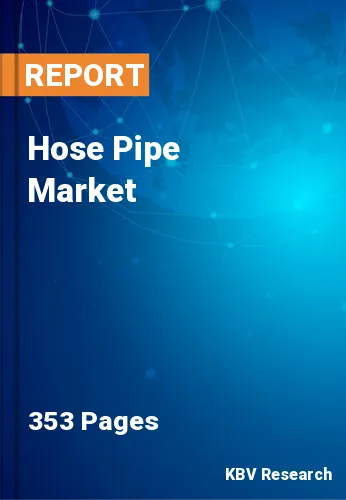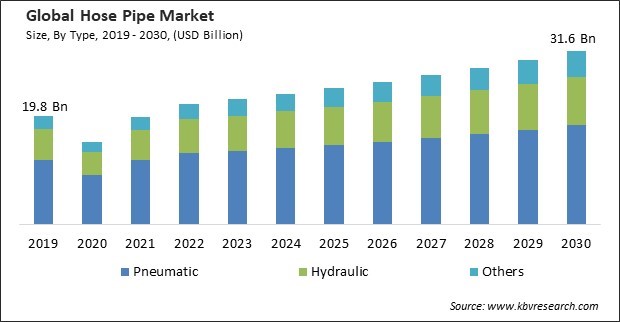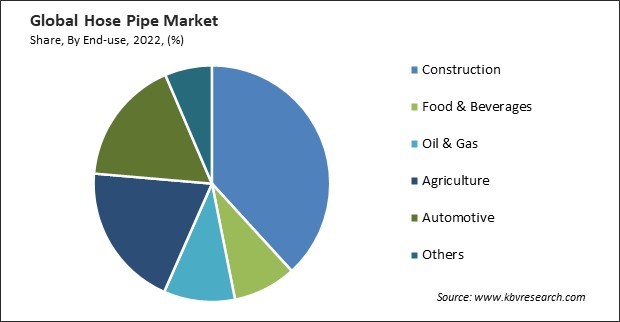
The Global Hose Pipe Market size is expected to reach $31.6 billion by 2030, rising at a market growth of 4.8% CAGR during the forecast period. In the year 2022, the market attained a volume of 6,827.5 million Meter experiencing a growth of 4.9% (2019-2022).
Construction projects often require the precise placement of concrete, typically done using hose pipes connected to concrete pumps. Therefore, Construction segment generated $8,377.3 million revenue in the market in 2022. As a result, these hoses transport the concrete from the mixer to the desired location, ensuring efficient and accurate pouring. They ensure a reliable water supply for various construction needs. Some of the factors impacting the market are growth in the automotive industry, increasing adoption in the manufacturing industry and fluctuating cost of raw materials.

The automotive industry's growth has significantly driven the hose pipe market. Hose pipes are crucial components within vehicles, used for various applications in automotive systems. Automotive engines generate substantial heat; hose pipes are essential cooling system components. Radiator and heater hoses transport coolant to regulate the engine's temperature, preventing overheating and maintaining optimal operating conditions. Hose pipes transport diesel or gasoline fuel from the fuel tank to the engine in internal combustion engine vehicles. Additionally, hose pipes efficiently transfer liquids, gases, and other fluids within manufacturing facilities. This includes the movement of water, chemicals, hydraulic fluids, oils, and more. Hose pipes transport solid materials, such as granules, powders, pellets, and grains. Therefore, the expansion of the automotive industry, both in terms of production volume and the incorporation of advanced technologies, contributes significantly to the growth of the market and the expansion of the manufacturing industry, both in terms of production volume and technological sophistication, is a crucial driver for the growth of the market.
However, manufacturers in regions with higher raw material costs may face challenges competing with companies with more affordable raw materials. This can influence market dynamics and competitiveness. They often rely on long-term relationships with raw material suppliers. Price fluctuations can strain these relationships and require renegotiations of supply agreements. Hose pipe manufacturers may need to implement adequate risk management techniques to mitigate the impact of raw material price volatility. This can include hedging strategies or diversifying the supplier base. Fluctuations in raw material quality or supplier changes due to cost concerns can impact the consistency and quality of hose pipes, potentially affecting customer satisfaction. These factors will decline the growth of the market.
By end use, the hose pipe market is classified into construction, automotive, oil & gas, food & beverages, agriculture, and others. The automotive segment recorded a remarkable revenue share in the market in 2022. Hose pipes are crucial in various automotive systems, helping transport fluids and gases. Hose pipes carry coolant from the radiator to the engine and back. Hose pipes route fuel vapors from the fuel tank to the vapor canister as part of the evaporative emission control system. Hose materials and designs vary based on the specific requirements of each application, ensuring proper fluid or gas transport while maintaining safety and durability. Regular inspection and maintenance of automotive hose pipes are essential to prevent leaks, ensure system performance, and maintain overall vehicle safety.

On the basis of type, the hose pipe market is segmented into hydraulic, pneumatic, and others. In 2022, the pneumatic segment dominated the market with the maximum revenue share. Pneumatic hose pipes are specialized hoses designed for pneumatic systems, which rely on compressed air or gas to transmit energy or power various mechanical components. These hoses are crucial in industrial applications requiring clean and efficient energy transmission. Pneumatic hose pipes are typically made from materials that can withstand compressed air or gas pressure and stresses. Smaller hoses are suitable for low-pressure applications, while larger hoses are used for high-pressure pneumatic systems. These hoses are designed to operate within a specific temperature range.
Based on material, the hose pipe market is fragmented into rubber, plastic, and others. In 2022, the rubber segment held the highest revenue share in the market. Rubber hose pipes are flexible and durable conduits made primarily of rubber or a combination of rubber and other materials. These hoses are widely used in various industries for transferring fluids, including liquids and gases, and they come in multiple sizes, types, and configurations to suit different applications. Rubber hose pipes are primarily made of synthetic rubber compounds, such as neoprene, nitrile, EPDM (ethylene propylene diene monomer), or natural rubber. Regular inspection and maintenance of rubber hose pipes are crucial to ensure their continued reliability and safety. Replacing hoses when they show signs of wear, damage, or aging is essential to prevent leaks and failures.
| Report Attribute | Details |
|---|---|
| Market size value in 2022 | USD 21.9 Billion |
| Market size forecast in 2030 | USD 31.6 Billion |
| Base Year | 2022 |
| Historical Period | 2019 to 2021 |
| Forecast Period | 2023 to 2030 |
| Revenue Growth Rate | CAGR of 4.8% from 2023 to 2030 |
| Number of Pages | 353 |
| Number of Table | 750 |
| Quantitative Data | Volume in Million Meter, Revenue in USD Billion, and CAGR from 2019 to 2030 |
| Report coverage | Market Trends, Revenue Estimation and Forecast, Segmentation Analysis, Regional and Country Breakdown, Companies Strategic Developments, Company Profiling |
| Segments covered | Type, Material, End Use, Region |
| Country scope | US, Canada, Mexico, Germany, UK, France, Russia, Spain, Italy, China, Japan, India, South Korea, Singapore, Malaysia, Brazil, Argentina, UAE, Saudi Arabia, South Africa, Nigeria |
| Growth Drivers |
|
| Restraints |
|
Region-wise, the hose pipe market is analysed across North America, Europe, Asia Pacific, and LAMEA. In 2022, the Asia Pacific region generated the largest revenue share in the market. The improvement in overall production facilities is likely to create opportunities for growth of the market in this region. The industrial sector, mainly food and beverages, chemical and petrochemicals, and pharmaceuticals is strong in Asia-Pacific. These industries' pipes supply various process fluids, including water, gas, chemicals, flavored beverages, steam, and others. Moreover, agriculture is a major regional sector, especially in India and China. Therefore, these countries and others in the region drive the demand for rubber and plastic hose pipes for irrigation.
Free Valuable Insights: Global Hose Pipe Market size to reach USD 31.6 Billion by 2030
The market research report covers the analysis of key stake holders of the market. Key companies profiled in the report include Parker Hannifin Corporation, Eaton Corporation PLC, Gates Industrial Corporation plc (Blackstone Inc.), Manuli Hydraulics UK Ltd, SHP Primaflex GmbH, Sumitomo Riko Company Limited, Nichirin Co., Ltd., Polyhose Inc, Continental AG and Colex International Ltd.
By Type (Volume, Million Meter, USD Billion/Million, 2019-2030)
By End Use (Volume, Million Meter, USD Billion/Million, 2019-2030)
By Material (Volume, Million Meter, USD Billion/Million, 2019-2030)
By Geography (Volume, Million Meter, USD Billion/Million, 2019-2030)
This Market size is expected to reach $31.6 billion by 2030.
Growth in the automotive industry are driving the Market in coming years, however, Fluctuating cost of raw materials restraints the growth of the Market.
Parker Hannifin Corporation, Eaton Corporation PLC, Gates Industrial Corporation plc (Blackstone Inc.), Manuli Hydraulics UK Ltd, SHP Primaflex GmbH, Sumitomo Riko Company Limited, Nichirin Co., Ltd., Polyhose Inc, Continental AG and Colex International Ltd.
In the year 2022, the market attained a volume of 6,827.5 million Meter experiencing a growth of 4.9% (2019-2022).
The Construction segment is generating highest revenue in the Market, by End Use in 2022; thereby, achieving a market value of $11.5 billion by 2030.
The Asia Pacific region dominated the Rubber Market, by region in 2022, and would continue to be a dominant market till 2030; thereby, achieving a market value of $8.4 billion by 2030.
Our team of dedicated experts can provide you with attractive expansion opportunities for your business.
